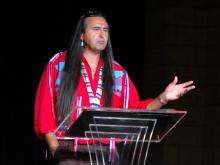restitution

A FEW MONTHS AGO, I was driving from Peterborough, Ontario, to my home at Six Nations Reserve. The route took me through the traditional homelands of the Anishinaabe.
I began to feel and smell the spirit of the ancestors. On the right were farmlands; on the left, townhouses. In the distance, I could see the metropolis of Toronto. This is where Anishinaabe walked, hunted, gathered, and lived for years before first contact with Europeans. When the settlers came, they built structures to suit their needs. They took over the land by force, trickery, and other means. The concept of buying and selling land is absent from the Indigenous way of life. You cannot sell what the Creator has given you.
Many churches in Canada were built on Indigenous land, first by the Church of England and then the Anglican Church of Canada (ACC). Six Anglican churches were built on the Six Nations where I live. They are a part of my Anglican history; I can trace my Anglican roots to the early 1700s. It is a rich history. And complicated.
It occurred to me: South Africa is no longer under legal apartheid, but apartheid still thrives here — through de facto economic segregation. There are no signs that say “whites only” as they did under apartheid, but there has also been no move by the black government to restore the people to the land that was taken from them.
One question haunted me: How does a white Christian South African live in this apartheid from day to day? 1) One must actively fight injustice, or 2) she must embrace a theology that has nothing to do with it.

ALL EYES WERE fixed on Richard Twiss, the Lakota/Sioux co-founder and president of Wiconi International, who stood center stage at the 2011 Christian Community Development Association conference.
Twiss pulled no punches as he told the truth about the church's role in colonization: The global genocide of indigenous peoples and the eradication of indigenous cultures by requiring people to cut their hair, leave their families, forsake their languages, and forswear their drums. Coaxed to convert or be damned, indigenous people exchanged their own culture for guitars and mission schools in order to be "Christian."
On Feb. 9, 2013, Richard Twiss passed to the other side of life. For many he was a key voice for indigenous people finding a way to reclaim their culture while keeping hold of Christ. While Twiss was a primary voice of the movement, he was also a member of a larger circle of indigenous leaders, each of whom has played his or her part to establish and spread the good news of cultural reconciliation after "500 years of bad haircuts," as Twiss liked to put it.
Twiss had enormous impact on the indigenous "contextual ministry" movement. "Contextualization means to present the good news of the shalom kingdom of Jesus Christ in a way that people can understand and relate to in their own cultural context," explained Randy Woodley (Keetoowah Cherokee), distinguished associate professor of faith and culture at George Fox Evangelical Seminary.